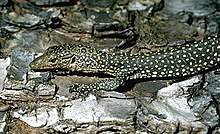红树巨蜥
| 红树巨蜥 | |
|---|---|

| |
| 科学分类 | |
| 界: | 动物界 Animalia |
| 门: | 脊索动物门 Chordata |
| 纲: | 爬行纲 Reptilia |
| 目: | 有鳞目 Squamata |
| 科: | 巨蜥科 Varanidae |
| 属: | 巨蜥属 Varanus |
| 种: | 红树巨蜥 V. indicus
|
| 二名法 | |
| Varanus indicus | |

红树巨蜥(学名:Varanus indicus,英语:mangrove monitor[2]、mangrove goanna或Western Pacific monitor lizard)是巨蜥属下的一种蜥蜴,广泛分布于澳大利亚、新几内亚到所罗门群岛、马绍尔群岛、加罗林群岛和马里亚纳群岛的太平洋地区。体长可达3.5至4英尺(1.1至1.2米)。
命名
[编辑]红树巨蜥由法国爬行动物学家弗朗索瓦·马里·多丹首次描述于1802年。[1] 当时的正模标本是安汶岛上发现的一只未成年红树巨蜥,后来这一标本在巴黎的博物馆中失踪。多丹给出的学名是Tupinambis indicus,此名称沿用七十五年后才被现名取代。[3]
属名Varanus 取自阿拉伯语 ورل (waral,即“巨蜥”)。[4] 种加词indicus即拉丁语“印度”之意,不过这里指的是最早发现红树巨蜥的印度尼西亚或东印度群岛。[3]
而本种的中文名称常常造成误会,认为体色如同其名,呈现红色;其实系因栖息环境主要在红树林地区所致。
因为分布广泛,红树巨蜥被认为是一种隐存种,其下包含至少四个姊妹种:Varanus indicus、蓝尾巨蜥(Varanus doreanus)、Varanus spinulosus 和桃喉巨蜥(Varanus jobiensis)。[5]
分布
[编辑]红树巨蜥广泛分布于澳大利亚、新几内亚到摩鹿加群岛、所罗门群岛、马绍尔群岛、加罗林群岛和马里亚纳群岛的太平洋地区。生活在沿河、红树林或湖泊边的潮湿丛林里。在这上千个岛屿中,其个体差异,如大小、图案以及鳞片形状也不尽相同。[3]日本在20世纪前期也将其引入。[6]一些爬行动物学家认为红树巨蜥之所以分布如此广泛是因为波利尼西亚人给他们提供了充足肉食的缘故。但也有学者认为红树巨蜥只能是与人类存在食物上的竞争关系,而且实际上并不嗜肉。[7]
形态
[编辑]
红树巨蜥体色呈深绿至黑色不等,身上有金黄色斑点。头部色彩较淡,腹部呈奶油色。[3] 其牙上有锯齿,舌头呈鲜艳的粉红色。[3][8]各地红树巨蜥大小不等,但很少超过1.5米(4英尺11英寸)。[3] 澳大利亚爬行动物学家Harold Cogger认为澳大利亚的红树巨蜥身长平均为1米(3英尺3英寸)。 [9]其尾巴的长度是体长的两倍左右,有助于其游泳。身体大部分都覆盖着椭圆的小型鳞片。[8]
红树巨蜥可以通过扩张舌骨器增大嘴巴吞下大型猎物,这一点同蛇相似,但其颌部还是僵硬的。[10] 红树巨蜥有犁鼻器用以探测猎物。[8]
红树巨蜥是除了V. semiremex之外唯一一种有盐腺的巨蜥,因此可以在咸水中生存并捕捉海生生物。[7]这使得其在海中游动成为可能,所以亦可能是其广泛分布的原因之一。[8]
食物
[编辑]红树巨蜥是一种机会主义食肉动物,食物包括蛋、鸟类、软体动物、啮齿动物、昆虫、螃蟹、小型蜥蜴、鱼类和腐尸。[9][11][12] 它是唯一一种可以在较深水域捕捉鱼类的巨蜥。[13]在某些地区据称还会捕食未成年的鳄鱼。[3]
南马里亚纳群岛的红树巨蜥食谱正在发生重大变化,原因是其传统食物正在减少。[6]关岛的红树巨蜥会以鼩鼱为食,[4]但因为棕树蛇入侵关岛而造成鼩鼱数量减少,红树巨蜥因此转而以无脊椎生物为食,也会去翻人类的垃圾箱。[4][6] 它也是关岛上少数几种可以对棕树蛇构成威胁的生物之一。[14]
繁殖
[编辑]红树巨蜥缺乏明显的两态性,只有关岛上的雄性红树巨蜥被报导体型是雌性的三倍。[4] 雄性会为了争斗配偶而争斗。交配时雄性会在骑到雌性背上之后用下巴摩擦雌性的头部和身体前端。[6] 交配时雄性和雌性可能会进行360度旋转,雄性一直保持上位。[6]
交配后,雌性会产下2至12枚卵,卵的长度约为3.5—5厘米(1.4—2.0英寸)。卵为白色、呈椭圆形,七至八个月后幼年红树巨蜥就会孵出。[15]现已有成功的人工繁殖记录。
与人类的关系
[编辑]1930年代,红树巨蜥被引入到一些太平洋岛屿上。[12][16]日本在二战之前也开始引入红树巨蜥以消灭鼠害,但后来失控,红树巨蜥开始袭击当地的鶏舍。[12]美军抵达时当地人还向之求助以消灭过多的红树巨蜥,而美方给出的意见是引入剧毒的海蟾蜍。[12]虽然红树巨蜥的数量得到了控制,但是鼠害又再度频发。[12]帕劳群岛也因同样的缘故引入了海蟾蜍,但红树巨蜥的大量死亡导致当地的椰子害虫猖獗起来。[16]
其皮可以用来制造磁鼓头,[17][18]虽然这种贸易规模较小,但仍有学者认为这是一种过度利用。[18]更多的地方只是将其当做食物,或者因其危害家养动物而将之捕杀。[8]关岛当地有一种传统食物是用红树巨蜥的肉制成的。[6]
红树巨蜥常见于动物园中,有时也被当成宠物来贸易。其性警觉而且被驯服后容易控制。[11]家养环境下可活20年以上。[11]
参考文献
[编辑]- ^ 1.0 1.1 Daudin, F.M. Histoire Naturelle, génerale et particulièredes reptiles, ouvrage faisant suite, a l'histoiure naturelle, générale et particulière composée par Leclerc de Buffon, et redigée par C. S. Sonnini 3. Paris. 1802 (法语).
- ^ Varanus indicus. ITIS. [2008-08-27].
- ^ 3.0 3.1 3.2 3.3 3.4 3.5 3.6 Sprackland, Robert. Mangrove monitor lizards. Reptiles Magazine. March 1997: 48–63.
- ^ 4.0 4.1 4.2 4.3 Pianka, Eric R.; King, Dennis; King, Ruth Allen. Varanoid Lizards of the World. Indiana University Press. 2004: 588. ISBN 0-253-34366-6.
- ^ Recommendations of the Nomenclature Committee. CITES. 1997-03-07 [2008-09-01]. (原始内容存档于2008-05-18).
- ^ 6.0 6.1 6.2 6.3 6.4 6.5 Mangrove Monitor Lizards. Honolulu Zoo. [2008-08-27]. (原始内容存档于2008-10-04).
- ^ 7.0 7.1 Cota, Michael. Varanus indicus and its Presence on the Mariana Islands: Natural Geographic Distribution vs.Introduction (PDF). BIAWAK (INTERNATIONAL VARANID INTEREST GROUP). 2/1/2008, 2 (1): 18–28 [2008-08-27]. (原始内容 (PDF)存档于2020-11-30).
- ^ 8.0 8.1 8.2 8.3 8.4 Bennett, D. (1995). A Little Book of Monitor Lizards. Viper Press, Aberdeen, U.K.
- ^ 9.0 9.1 Cogger, H. (1967). Australian Reptiles in Colour. Sydney: A. H. & A. W. Reed, ISBN 0-589-07012-6
- ^ King, Dennis & Green, Brian. 1999. Goannas: The Biology of Varanid Lizards. University of New South Wales Press. ISBN 0-86840-456-X
- ^ 11.0 11.1 11.2 Sprackland, Robert. (1992). Giant Lizards. TFH Publications. ISBN 0-86622-634-6.
- ^ 12.0 12.1 12.2 12.3 12.4 Dryden, G. (1965). The food and feeding habits of Varanus indicus on Guam. Micronesica 2(1):73-76
- ^ Traeholt, C. (1993). Notes on the feeding behaviour of the water monitor, Varanus salvator. Malay. Nat. J.46: 229-241.
- ^ Fritts, T.H.; D. Leasman-Tanner. The Brown Treesnake on Guam: How the arrival of one invasive species damaged the ecology, commerce, electrical systems, and human health on Guam: A comprehensive information source. U.S. Department of the Interior. 2001 [2008-09-11]. (原始内容存档于2008-12-07).
- ^ Bennett, Daniel. (1998). Monitor lizards: Natural history, biology & husbandry. Edition Chimaira. ISBN 3-930612-10-0.
- ^ 16.0 16.1 Uchida, T. (1967). Observations on the monitor lizard, Varanus indicus (Daudin) as a rat control agent on Ifaluk, Western Caroline Islands. Micronesica 3(1):17-18
- ^ Love, J.W. Australia and the Pacific Islands. Garland encyclopedia of World Music (Routledge). 2/1/2008, 9: 1008. ISBN 0-8240-6038-5.
|year=与|date=不匹配 (帮助); - ^ 18.0 18.1 Sprackland, R. G. (1993). Rediscovery of a Solomon Islands monitor lizard (Varanus indicus spinulous) Mertens, 1941. Vivarium, 4(5), 25-27.
|
Text is available under the CC BY-SA 4.0 license; additional terms may apply.
Images, videos and audio are available under their respective licenses.
